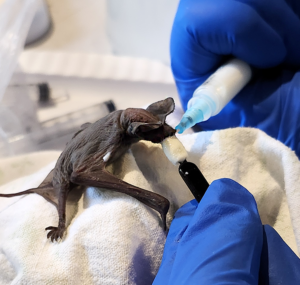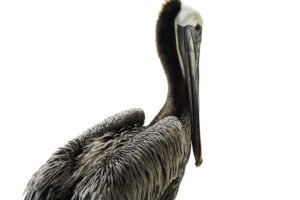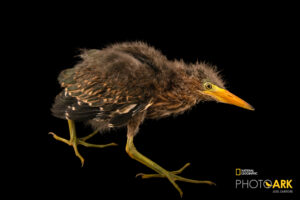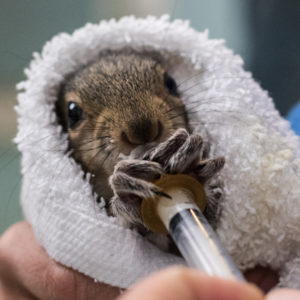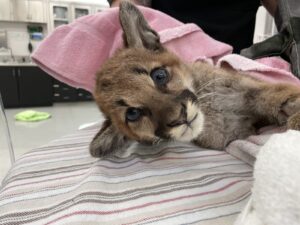| ALERT: Every spring and summer, concerned people find and rescue fawns that seem to have been abandoned by their mothers. In reality, healthy baby fawns are frequently left alone for up to twelve hours while their mothers forage for food. In past years, a high percentage of the fawns brought to Native Animal Rescue have been successfully reunited with their mothers where they have a much better chance of surviving into adulthood. Don’t become an accidental “kidnapper.” The following story tells how the staff at WildCare determined if a young fawn brought to the center was “kidnapped” and could be returned to its mother. Reading this story will help us all make better decisions to rescue or not to rescue when we encounter wildlife babies who seem to be alone in the wild. |
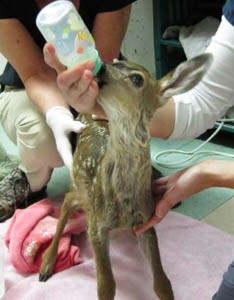
This wobbly-legged fawn learned quickly to suckle from a bottle. His eagerness to accept the bottle and the tasteless hydrating solution inside was an indication that he had been orphaned. Photo by Alison Hermance
Previously published by WildCare of Marin County, April 2014
The Marin Humane Society (MHS) officer who brought this fawn to WildCare wasn’t sure the baby deer actually needed to be admitted as a patient.
The family that found the fawn had contacted MHS about a dead doe, a female deer, earlier that day that had probably been hit by a car.
Then the family saw this spotted fawn.
WildCare Medical Staff and the MHS officer speculated that he could be the fawn of the dead doe, or he could belong to a different doe entirely. It’s fawn season, and if you look, you’ll see many wobbly-legged little fawns right now.
To make sure, the officer brought this baby to WildCare.
Medical Staff performed an exam, hoping that they would find the full belly and good hydration that indicated this baby’s mother was alive and well. In that case, the fawn could be returned to his mother’s care.
But the exam quickly revealed that this baby had an empty belly and was dehydrated. Even more tellingly, he had a bad case of diarrhea and fly eggs on his bottom that indictated it had been a while since he had last received a healthy meal of mother’s milk and her care.
Clearly this baby was not a “kidnap” victim— he was orphaned and would need to stay at WildCare to be raised with other orphaned fawns in our Foster Care system.
How do you know if a wild animal needs your help?
Every spring WildCare admits a number of baby animals that have been “kidnapped” by well-meaning people who found them alone and assumed they needed help. In fact, one in five of the fawns brought to WildCare in 2013 were healthy and were promptly returned to their mothers.
While every wildlife rescue is done for the most benevolent of reasons, “kidnapping” a healthy baby can have far-reaching impacts on the health of both mom and baby.
The first things to look for if you think a fawn needs rescue are the Five C’s. If a fawn demonstrates any of these five symptoms, it is an emergency and he needs immediate help:
1. Is he Crying?
2. Is he Coming toward you (approaching people)?
3. Is he Covered with blood or insects?
4. Has he been Caught by a cat or a dog?
5. Is he Cold?
If the answer to any of these questions is yes, this baby needs help immediately.
In the case of fawns, observing any one of the Five C’s indicates that the baby does need help. A fawn’s primary defense mechanism is to stay completely still and quiet, nestled into whatever spot his mother placed him while she went off to forage. When approached by a perceived predator (humans, pets or wildlife) a fawn’s instinctual response is to lay very low and not move at all. People often mistake this defensive behavior for injury, weakness or illness. Don’t be misled…this fawn is fine and should not be removed. A still, quiet fawn is a healthy fawn.
| Native Animal Rescue receives several calls a week during fawn season from concerned people who find the little animals in their yards or on walks. Answering the Five C’s will help you determine whether a fawn actually needs to be rescued or if the fawn is fine and just waiting for its mother to return. If the answer to any of the Five C’s is “yes,” the fawn needs to be rescued and brought directly to Native Animal Rescue at 1855 17th Avenue, Santa Cruz. If you have questions, call Native Animal Rescue’s Hotline at 831-462-0726. |
What does a crying fawn sound like?
Click for a recording of the heart-rending call a fawn makes when he’s upset. Upon hearing the sound, this fawn’s rescuer originally thought he had an exotic bird in his yard.
This recording is useful for a very specific purpose — to assist reuniting healthy “kidnapped” fawns with their mothers. If a mother deer is nearby and hears her baby crying, she will usually come running. But, as you know, a healthy fawn knows his best self-defense is to stay still and quiet. When attempting the reunite the fawn with its mother, the recorder playing the cry is left near the fawn while the people step away to observe from a distance. It is a very effective tool that will often bring the mother deer quickly.
Fortunately, it is a complete myth that a mother wild animal won’t accept her baby if he has human scent on him (it’s not true about birds either!), so a mother deer attracted by crying calls will immediately take her baby back and lead him to a safer spot.

